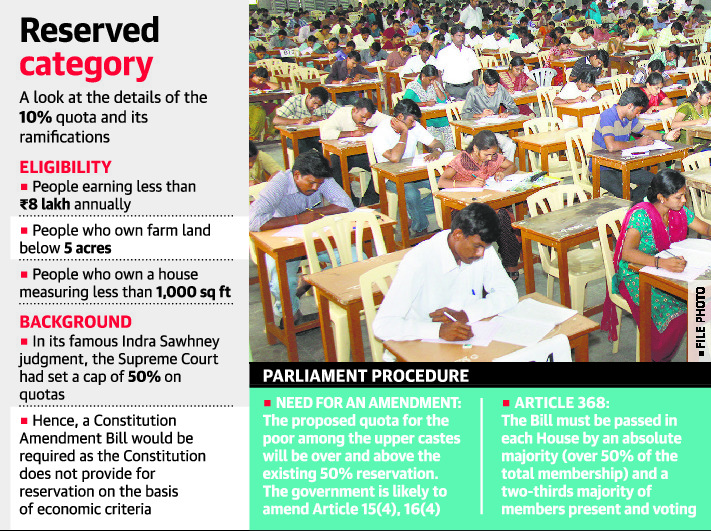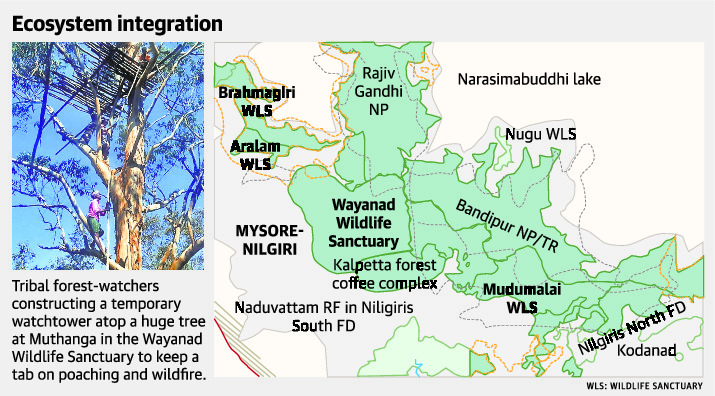IASbaba's Daily Current Affairs Analysis
Daily Current Affairs IAS UPSC Prelims and Mains Exam – 8th January 2019
Archives
(PRELIMS + MAINS FOCUS)
Reservation to the economically backward sections
Part of: GS Prelims and Mains II – Social/Welfare issue; Reservation issue; Polity
In news:
- Centre plans 10% reservation to the economically backward sections in the general category.
- Those who have an annual salary of less than ₹8 lakh per year and possess less than 5 acres of land will be able to avail themselves of reservation in educational institutions and jobs.
- A Constitution Amendment Bill was approved by the Cabinet in this regard.
- The Bill will also cover those from the Muslim, Sikh, Christian, Buddhist and other minority communities.
- The quota will be over and above the existing 50% reservation to the Scheduled Castes, the Scheduled Tribes and the Other Backward Classes (OBC).

Pic: https://d39gegkjaqduz9.cloudfront.net/TH/2019/01/08/DEL/Delhi/TH/5_01/23c0b880_2651798_101_mr.jpg
Do you know?
- Indira Sawhney case – In this case, Supreme Court had capped reservation at 50%.
- The judgment also held that Economic backwardness cannot be the sole criterion.
- Why Constitution Amendment Bill?
- Articles 15 and 16 of the Constitution will have to be amended for the implementation of the decision.
- The government proposes to bring the 10% over and above the 49% quota — 15% for Scheduled Castes, 7% for Scheduled Tribes and 27% for Socially and Educationally Backward Classes, including widows and orphans of any caste, which is permitted. But a total 59% (49%+10%) quota would leave other candidates with just 41% government jobs or seats. This may amount to “sacrifice of merit” and violate Article 14.
National park/Wildlife Sanctuaries in news:
Some of the important National parks/Wildlife Sanctuaries in Karnataka
- Bandipur National Park
- Bannerghatta National Park
- Kudremukh National Park
- Anshi National Park
- Dandeli Wildlife Sanctuary
- Pushpagiri Wildlife Sanctuary
- Bhadra Wildlife Sanctuary
- Brahmagiri wildlife sanctuary
- Cauvery Wildlife Sanctuary
Some of the important National parks/Wildlife Sanctuaries in Tamil Nadu
- Mudumalai WLS and NP
- Annamalai / Indira Gandhi WLS and NP
- Point Calimere WS
- Satyamangalam WS
- Pulicat Lake WLS

Pic: https://d39gegkjaqduz9.cloudfront.net/TH/2019/01/08/DEL/Delhi/TH/5_05/0e599e00_2651859_101_mr.jpg
Centre okays Citizenship Bill
Part of: GS Mains II – Indian Polity and Governance
In news:
- Union Cabinet cleared the redrafted Citizenship Amendment Bill.
- The Bill paves the way to grant citizenship to six religious minorities — Hindus, Jains, Sikhs, Parsis, Christians and Buddhists — from Pakistan, Afghanistan and Bangladesh who came to India before 2014.
- However, there has been a strong resistance to the Bill (especially in Assam) as it would pave the way for giving citizenship, mostly to illegal Hindu migrants from Bangladesh, in Assam who came after March 1971, in violation of the Assam Accord of 1985.
(MAINS FOCUS)
ENERGY/DISASTER MANAGEMENT
TOPIC:General studies 3
- Government policies and interventions for development in various sectors and issues arising out of their design and implementation.
- Infrastructure: Energy
- Science and Technology- developments and their applications and effects in everyday life
- Disaster and disaster management.
- Conservation, environmental pollution and degradation, environmental impact assessment.
Jaitapur Nuclear Power Plant issue
The Jaitapur nuclear power project issue is back in news after French company Électricité de France (EDF) submitted a “techno-commercial proposal” to the Indian government (in Decemeber 2018) for the Jaitapur nuclear power project in Maharashtra.
Do you know?
- India and France had on March 10 inked an agreement to expedite the Jaitapur nuclear power plant project, with the aim of commencing work at the site around the year-end.
- Once installed, the Jaitapur project will be the largest nuclear power plant in the world, with a collective capacity of 9,900 MW.
- The Indo-French nuclear agreement was signed in 2008 and it was decided to build a nuclear power plant in Jaitapur, some 600 km south of Mumbai. The power plant will have six nuclear European Pressurised Reactors (EPRs) with a capacity of 1,650 MW each.
- In March 2018, EDF and the Nuclear Power Corporation of India (NPCIL) signed an “industrial way forward” agreement in the presence of Prime Minister Narendra Modi and French President Emmanuel Macron.
Concerns:
- Locals of Jaitapur and some organisations have been opposing the project in the area citing safety and environmental concerns (especially due to EPRs).
- Earlier questions about costs and safety remain unanswered.
- With the Indian power sector facing surplus capacity and a crisis of non-performing assets (NPAs), a large investment in the Jaitapur project is particularly risky.
- Electricity from the Jaitapur project to be more expensive (₹15 per kilowatt-hour or even more) than many other sources of electricity, including solar and wind power.
- Across the world, EPRs have experienced delays and cost increases. The first EPR entered commercial operation in December 2018 at the Taishan site in China, five years later than originally projected (with final capital cost increasing over 40% over the original estimate). The story in Europe is more dramatic.
- Safety problems – Safety problems with the reactor design and construction have emerged in several EPRs (especially pertained to the pressure vessel, which is the key barrier that prevents the spread of radioactive materials from the reactor).
- EPRs at Flamanville (France) and Taishan (China), Olkiluoto in Finland – encountered problems.
- These safety concerns are exacerbated by India’s flawed nuclear liability law.
Alternative sources of energy
- While nuclear costs have been rising, other low-carbon sources of electricity, especially solar energy, have become cheaper.
- In 2010-11, tariffs for solar photovoltaic (PV) projects under the National Solar Mission were between ₹10.95 and ₹12.76 per unit. Today it is below ₹5 per unit.
- In recent auctions for solar PV projects, winning tariff bids in the range of ₹2 to ₹2.50 per unit have become routine.
Do you know?
- In March 2018, the parliamentary standing committee on energy listed 34 “stressed” projects, including NPAs and “those which have the potential to become NPAs”.
- It estimated an outstanding debt of ₹1.74 lakh crore.
- If the Jaitapur project encounters financial difficulties, the costs would fall on Indian taxpayers.
Connecting the dots:
- Nuclear reactors are yet to find acceptance in the minds of people, especially after post Fukushima disaster. Is nuclear energy a feasible option for high energy demanding and consuming India?
- Critically analyse the need for making India independent in nuclear energy capabilities. Also, throw light on the recent progress of nuclear development in India.
DISASTER MANAGEMENT
TOPIC:General studies 3
- Government policies and interventions for development in various sectors and issues arising out of their design and implementation.
- Disaster and disaster management.
Meghalaya tragedy: show how little the lives of the poor matter in India
Context:
- 15 workers were trapped inside in a rat-hole coal mine since mid-December (who are feared to be dead by now due to delayed rescue operations).
- A second disaster had struck Meghalaya’s illegal coal mines in less than a month, claiming the lives of two miners.
- Similar mine-flooding accident had claimed 15 lives in 2012 in South Garo Hills.
- India recorded 377 mine deaths in 3 years
Much like the Meghalaya tragedy, other disasters—some driven by policy and others where policymakers look away—show how little the lives of the poor matter in India.
Reasons:
- The tardy response of the Centre and the State of Meghalaya has exposed the extraordinary indifference in government to labour welfare and the law.
- The primary responsibility for the operation of illegal mines lies with the State government. It should be called to account for ignoring the directions of the National Green Tribunal to close them and levy punitive royalties on those that extracted the coal.
- Also violation of rules under the Mines and Minerals (Development and Regulation) Act, the responsibility lies with the State government.
- Justice B.P. Katoki committee appointed by the NGT had warned about the continued operation of the illegal mines. However, Meghalaya government failed to act and take appropriate actions.
- Mineral resources should have been treated as state property.
The utter indifference of the state government to find a permanent solution to this recurrent tragedy is significant for two reasons.
- First, it appears that the lives of poor mine workers who are often migrants from Assam or illegal entrants from neighbouring Bangladesh matter little.
- Second, the state is seemingly complicit in the tragedy by not only allowing a banned enterprise but also collecting taxes from the transport of illegally harvested coal, bringing into scrutiny the elites’ disregard for the rule of law.
Public policy disasters
Other disasters and tragedies due to poor policies and actions by the State
- Over the past year, at least 17 people are likely to have succumbed to hunger in Jharkhand, which is among the poorest states in India, as they failed to link their biometric identification or Aadhaar number with their ration cards, which guarantee highly subsidised food under the National Food Security Act.
- Because of demonetization, more than a 100 people are estimated to have died either while standing in queues for long hours or for failing to provide new banknotes while getting treated in hospitals.
- An uncounted number of labourers die because of silicosis after inhaling stone dust while working in quarries in states such as Rajasthan and Gujarat.
These deaths can be prevented by using face masks and goggles and by using wet drilling, but mine owners continue to ignore occupational health regulations.
Rich consumers who extensively use stones as construction material in their homes remain unaware of the human costs involved.
The same holds true of the recurrent deaths of sanitation workers.
In the national capital alone, more than 20 labourers have died in the past year inhaling poisonous gases while cleaning sewers and sewage treatment tanks, despite the federal government’s thrust on sanitation and cleanliness.
Conclusion:
- State government has done little to implement reforms and diversify employment away from dirty mining under primitive conditions over the years, in spite of judicial orders.
- It is the responsibility of the Centre and the State to rehabilitate the workers from impoverished communities, reportedly including some child labourers, who are ready to undertake the risky labour because of the higher-than-average wages paid.
Connecting the dots:
- Recent deaths and tragedies at illegal mines and rat-hole mines highlight the need for urgent policy reforms. Discuss. What strategies would you suggest to prevent and mitigate the effects of such accidents?
(TEST YOUR KNOWLEDGE)
Model questions: (You can now post your answers in comment section)
Note:
- Featured Comments and comments Up-voted by IASbaba are the “correct answers”.
- IASbaba App users – Team IASbaba will provide correct answers in comment section. Kindly refer to it and update your answers.
Q.1) Consider the following statements with regard to 1992 Indra Sawhney judgement:
- Supreme Court held that the “test or requirement of social and educational backwardness cannot be applied to Scheduled Castes and Scheduled Tribes, who indubitably fall within the expression ‘backward class of citizens’.”
- It laid down a 50 per cent limit on reservations and observed that economic, social and educational criteria were needed to define backward classes.
- The judgment also held that Economic backwardness cannot be the sole criterion.
Which of the statements given above is/are correct?
- 1 and 2 only
- 2 and 3 only
- 2 only
- 1, 2 and 3
Q.2) Anshi National Park is located in –
- Kerala
- Karnataka
- Uttar Pradesh
- Odisha
Q.3) Point Calimere WS is located in –
- Kerala
- Karnataka
- Tamil Nadu
- Andhra Pradesh
MUST READ
Still nothing to show for: on Imran Khan’s performance so far as PM
A different outreach: on Modi government and religion
Raja Mandala: The centre moves east
‘Even if there isn’t friendship between govt and media, there shouldn’t be animosity’
The reservation jumla












